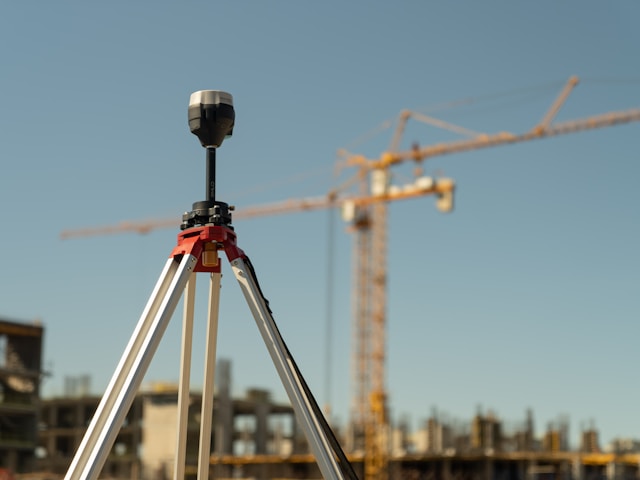
Land surveying offers vital information about the worksite to civil engineers and architects, giving them location-specific details necessary for the job.
For example, the land surveyor can also give a civil engineer information on where precisely the bridge footings must be located. The civil engineer can then decide how much weight the bridge can sustain as well as the particular building strategies that should be used for it.
The surveyor will just about always be used for surveying the site before construction starts. This ensures the engineers will have an optimal location for the structure to be built. Additionally, any designs crafted by an engineer must consider the layout of the land. A civil engineer must never assume the land is completely flat and all set for construction. The land surveyor gives information about the topography, aiding the civil engineer with creating plans that account for the land’s deficiencies.
The land surveyor will typically be included in the blueprint development phase of the project, providing information like boundary information and GPS coordinates that will then be given to the construction team.
What is Land Surveying?
Land surveying is the ability to decide the relative position of points above, below, and on the earth’s surface. It is accomplished by measuring the horizontal spaces between those points. Land surveying also entails the method of creating points by predetermined angular and linear measurements.
Land surveying uses a combination of technical, scientific, and mathematical skills to create precise distances, angles, and positions on the Earth’s surface. The main purpose of land surveying is to offer correct data that helps in decision-making during the different stages of a project.
Why Land Surveying is Necessary
No project can be built accurately until a land survey is done since the final version of a project can’t be planned out for the civil engineers and construction crew.
Here are some various types of surveys that could be a part of a civil engineering project:
Control survey – Decides horizontal and vertical positions of control points.
Construction stakes out – Determines the point below and/or above ground and stakes the location as it pertains to the land and project.
Land survey – Establishes the property and boundary lines. This also contains building setbacks, easements, and other data as it pertains to the property boundaries.
Topographic – Produces a contour map of a region that has natural and man-made features on the property.
The Significance of Land Surveyors
Land surveyors are crucial in all facets of development and can help civil engineers, land planners, architects, and property owners as well as many other fields.
Land surveyors help resolve land issues in our world. Without these professionals, civil engineering projects, development projects, and construction projects would not be completed accurately. Additionally, there would be issues with construction progress and property disputes.
Importance of Land Surveying in Civil Engineering
One of the significant roles of land surveying in civil engineering projects is to give exact data that civil engineers can put in their proposals. With ultra-precision measurements of
boundaries, angles, and elevations, they can make sure project plans are established with dependable information that is believable. Land surveyors also play a critical role in assessing land with a high risk of property disputes or damage, delivering a professional’s unbiased opinion and important details.
Additionally, land surveying is very effective when legal conflicts surface between private and public entities regarding land ownership. They are a neutral third party who can evaluate the situation and truthfully solve the dispute.
Land Surveying Tasks
Planning and layout: Correct land survey data allows civil engineers to generate detailed plans and integrate crucial elements like drainage systems, building footprints, and roadways. This data is essential for the best project layout.
Site assessment: Land surveying has a key role in assessing possible construction sites. By performing detailed surveys, civil engineers can evaluate environmental factors, topography, and soil conditions that affect project feasibility.
Construction: During construction, land surveying makes sure that buildings are constructed correctly based on the accepted plans. Land surveyors create markers and lead construction crews to retain accuracy.
Ensuring exactness: Land surveyors use innovative measurement practices to get high levels of exactness in deciding elevation, distances, and angles. This accuracy aids in preventing errors and expensive rework.
Detecting possible risks: By performing comprehensive surveys, civil engineers can detect possible risks and dangers in the construction place, like environmental restrictions and unbalanced soil conditions, allowing educated decisions for risk mitigation.
Purposes Of Land Surveying in Civil Engineering
There are several purposes of land surveying in civil engineering including:
- To examine the construction site for its appropriateness for civil engineering projects.
- To measure, inspect, and correctly verify the relative heights of different objects and points in their relative location.
- To correctly create the property’s boundaries from existing records.
- To establish spot levels, contours, maps, and profiles by charting the dimensions to an appropriate scale.
- To assess the area and amounts of various materials, like earthwork, entailed in the different engineering projects like canals, railways, roads, etc.
The Relationship Between Land Surveyors and Civil Engineers
Civil engineers can be educated in numerous types of construction such as structural, mechanical, or architectural. Each type of civil engineer works on certain types of construction projects or is used in specific parts of that project. In any situation, that civil engineer will partner with a land surveyor.
A land surveyor will practically always be used for surveying the site before the construction project begins. This ensures the civil engineers will have a peak location for the structure to be constructed. Additionally, any designs created by an engineer must consider how the land lies.
As construction continues, the land surveyors ensure that every detail of the civil engineer’s plans is fulfilled. This frequently entails correctness down to the centimeter of the civil engineer’s plans and continually executing checks to guarantee the structure is aligned with the appropriate location on the property.
Today’s advanced technology has made these procedures easier. However, many projects still necessitate a team of land surveyors and civil engineers to make all the essential calculations at a worksite.
Land Surveying Methods
The following are the different methods of land surveying:
Plane surveying – Plane surveying is a valuable branch of surveying, usually depended on for measuring the area of land or plots. This surveying type simplifies the model of the earth’s surface by considering it as a planar surface, disregarding its spherical form. For its hands-on usability, plane surveying is typically used for architecture, military, engineering, navigational, and commercial purposes.
Geodetic surveying – Geodetic surveying is a critical type of surveying that takes into account the shape of the earth, letting curved lines be assessed and included in survey work. Geodetic surveying permits wide areas to be correctly mapped and better control can be had over surveying activities. It also gives important data, like height above sea level, points position, and more with better consistency and accuracy in the survey results.
Total-station surveying – A total station is a must-have tool for today’s civil engineers and land surveyors. Using current technology like angle sensors, electronic distance meters, and optics, this cutting-edge piece of equipment precisely examines both the vertical and horizontal angles within a matter of seconds. Not only is it extraordinarily accurate, but it’s also astonishingly portable, letting users easily carry it between work sites.
Tachometric surveying – Tachometric surveying is a helpful practice to encourage effectiveness within angular surveying. It removes the need for chaining, generating quicker results. While this technique is faster than using chaining, it creates less precise readings, which must be taken into consideration when depending on its results.
GPS – GPS technology has revolutionized the surveying field by delivering better data collection correctness. It lets land surveyors easily and swiftly measure distances, land boundaries, terrains, and structures with remarkable precision. With the usage of GPS for surveying, big-scale projects that would require days and weeks to finish can now be completed in one day.
High-accuracy receivers can deliver an even greater inch-level resolution for applications like mapping as well as civil engineering projects.
Choose Baseline for Land Surveying Projects in Colorado
At Baseline, we know the significance of accuracy and precision in land surveying. Our team provides professional civil engineering consulting on:
- Roads and bridges (highways, roadways, culverts, bridges, and roundabouts)
- Utility systems (sewer systems, utility inspections, and storm water systems)
- Wastewater systems
With our experience, knowledge, and skills, we are confident that we can aid clients in providing excellent results within anticipated timelines. With our innovative techniques, we ensure measurements and data with a high degree of correctness.
For more information about how land surveyors and civil engineers work together and the advantages of partnering with highly skilled, experienced land surveyors in Colorado, we encourage you to contact our team at Baseline Engineering Corporation and we will be happy to answer any questions.



